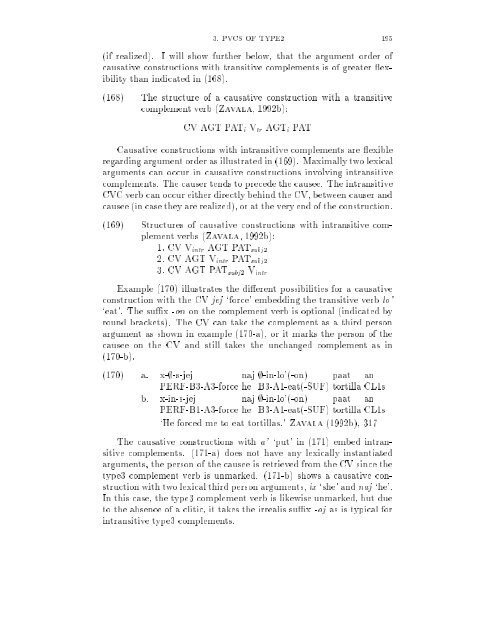Perception verb complements in Akatek, a Mayan language
Perception verb complements in Akatek, a Mayan language
Perception verb complements in Akatek, a Mayan language
Create successful ePaper yourself
Turn your PDF publications into a flip-book with our unique Google optimized e-Paper software.
3. PVCS OF TYPE2 195<br />
(if realized). I will show further below, that the argument order of<br />
causative constructions with transitive <strong>complements</strong> is of greater exibility<br />
than <strong>in</strong>dicated <strong>in</strong> (168).<br />
(168) The structure of a causative construction with a transitive<br />
complement <strong>verb</strong> (Zavala, 1992b):<br />
CV AGT PATi Vtr AGTi PAT<br />
Causative constructions with <strong>in</strong>transitive <strong>complements</strong> are exible<br />
regard<strong>in</strong>g argument order as illustrated <strong>in</strong> (169). Maximally two lexical<br />
arguments can occur <strong>in</strong> causative constructions <strong>in</strong>volv<strong>in</strong>g <strong>in</strong>transitive<br />
<strong>complements</strong>. The causer tends to precede the causee. The <strong>in</strong>transitive<br />
CVC<strong>verb</strong> can occur either directly beh<strong>in</strong>d the CV, between causer and<br />
causee (<strong>in</strong> case they are realized), or at the very end of the construction.<br />
(169) Structures of causative constructions with <strong>in</strong>transitive complement<br />
<strong>verb</strong>s (Zavala, 1992b):<br />
1. CV V<strong>in</strong>tr AGT PATsubj2<br />
2. CV AGT V<strong>in</strong>tr PATsubj2<br />
3. CV AGT PATsubj2 V<strong>in</strong>tr<br />
Example (170) illustrates the di erent possibilities for a causative<br />
construction with the CV jej `force' embedd<strong>in</strong>g the transitive <strong>verb</strong> lo'<br />
`eat'. The su x -on on the complement <strong>verb</strong> is optional (<strong>in</strong>dicated by<br />
round brackets). The CV can take the complement as a third person<br />
argument as shown <strong>in</strong> example (170-a), or it marks the person of the<br />
causee on the CV and still takes the unchanged complement as<strong>in</strong><br />
(170-b).<br />
(170) a. x-;-s-jej<br />
naj ;-<strong>in</strong>-lo'(-on) paat an<br />
PERF-B3-A3-force he B3-A1-eat(-SUF) tortilla CL1s<br />
b. x-<strong>in</strong>-s-jej naj ;-<strong>in</strong>-lo'(-on) paat an<br />
PERF-B1-A3-force he B3-A1-eat(-SUF) tortilla CL1s<br />
`He forced me to eat tortillas.' Zavala (1992b), 317<br />
The causative constructions with a' `put' <strong>in</strong> (171) embed <strong>in</strong>transitive<br />
<strong>complements</strong>. (171-a) does not have any lexically <strong>in</strong>stantiated<br />
arguments, the person of the causee is retrieved from the CV s<strong>in</strong>ce the<br />
type3 complement <strong>verb</strong> is unmarked. (171-b) shows a causative construction<br />
with two lexical third person arguments, ix `she' and naj `he'.<br />
In this case, the type3 complement <strong>verb</strong> is likewise unmarked, but due<br />
to the absence of a clitic, it takes the irrealis su x -oj as is typical for<br />
<strong>in</strong>transitive type3 <strong>complements</strong>.

















